#Lord Howe Island Stick Insect
Text
World's 'Rarest Insect' Makes Stunning Comeback After Near-Extinction : ScienceAlert
63 notes
·
View notes
Text
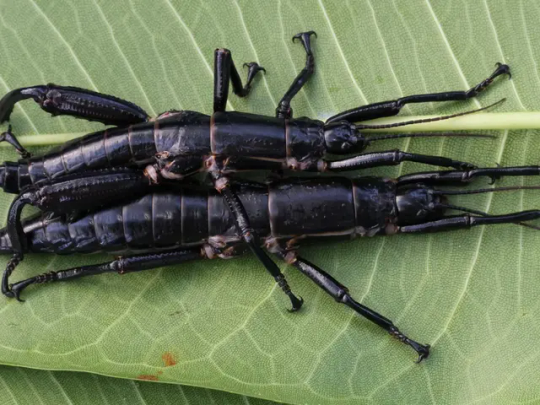
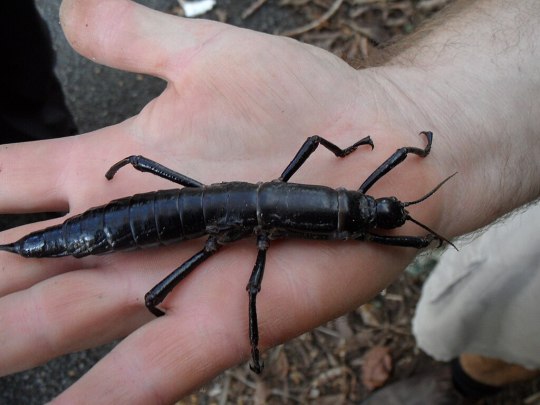
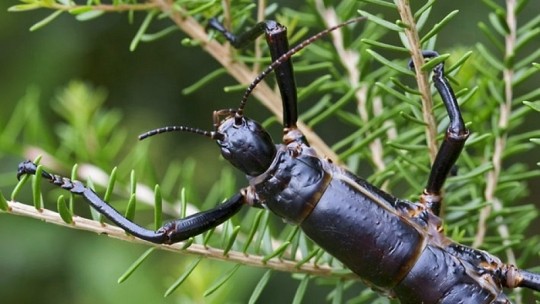
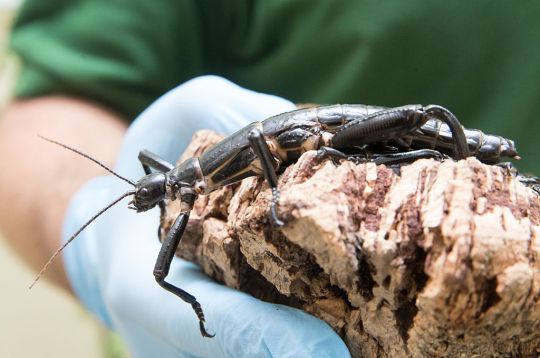


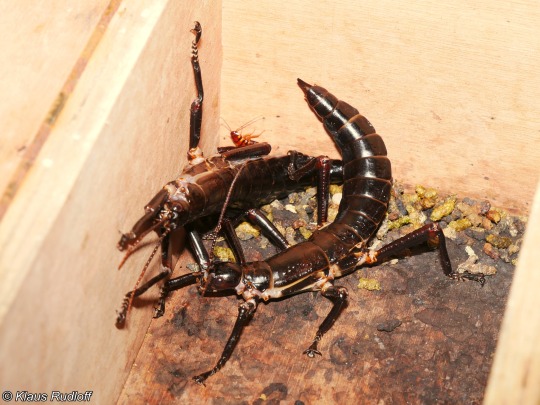
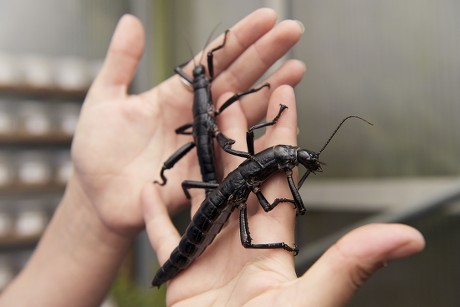
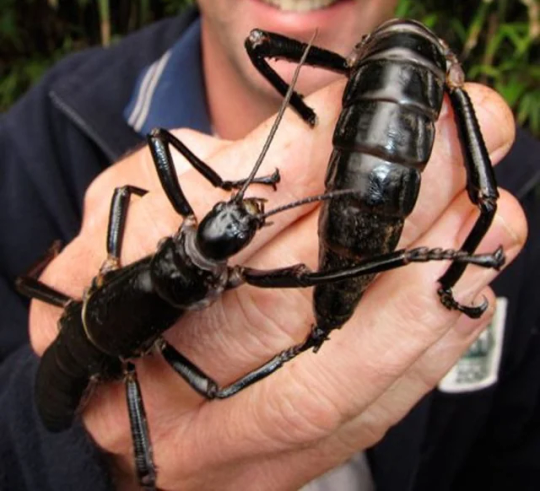
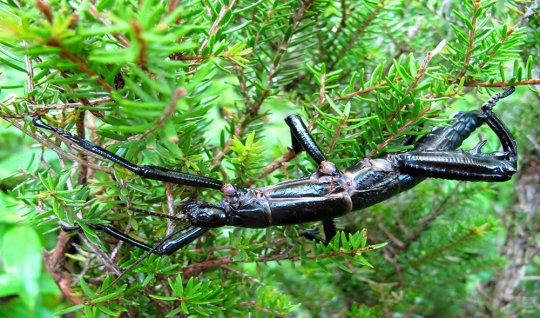

Dryococelus australis, commonly known as the Lord Howe Island stick insect or tree lobster, is a species of stick insect endemic to the Lord Howe Island Group, and the only member of the monotypic genus Dryococelus. Thought to be extinct when it was extirpated from Lord Howe Island itself by 1920, it was rediscovered in 2001 when a population of just 24 individuals was found living on the small islet of Ball's Pyramid. These stick insects were once very common on Lord Howe Island, where they were frequently collected by fishing vessels to be used as bait. They were believed to have become extinct soon after the supply ship SS Makambo ran aground on the island in 1918, allowing black rats, the primary predators, to become established. After 1920, no stick insects could be found. In 1964 a team of climbers visiting the towering sea stack known as Ball's Pyramid, discovered the recently deceased corpse of one of these stick insects. However it wouldn’t be until 2001 when an expedition to find whether any population persisted on the Pyramid was launched lead by David Priddel and Nicholas Carlile, the team discovered some 24 individual Lord Howe Island Stick insects living in and under a single under a single Melaleuca shrub some 330ft (100m) above the sea. In 2003, a research team from New South Wales National Parks and Wildlife Service returned to Ball's Pyramid and collected two breeding pairs, after intial difficulties captive breeding was achieved and now there are over 13,000 individuals with captive breeding programs occurring at the Melbourne, Bristol, San Diego, and Toronto Zoos as well as a special rat free habitat on Lord Howe Island. Reaching up to 8 inches (20 cms) in length and around 1 oz (25g) in weight, the Lord Howe Island stick insect is a large, flightless, nocturnal insect which has a stout body, long sturdy legs, and lack wings. Females have a broad abdomen with an ovipositor while males are more slender but have longer and thicker antennae and enlarged hind legs. Juveniles, called nymphs, are bright green for the first few months of life and active during the day; adults are a dark, glossy brown-black. They are a social and herbivorous species which feeds upon leaves, buds, and fruit, living together in groups of up to a dozen individuals. Unusual for most insects, these stick insects form bonded pairs that mate for life. The females lay up to 300 eggs in the soil which she carefully buries. Said eggs hatch around 6 to 9 months later, the young reach sexual maturity at around 7 months of age. And under ideal conditions a lorde howe island stick insect may like up to 2 years.
#pleistocene#pleistocene pride#pliestocene pride#pliestocene#cenozoic#bug#lord howe island#lord howe island stick insect#stick insect#insect#tree lobster
17 notes
·
View notes
Text
Animal of the Day!
Lord Howe Island Stick-insect (Dryococelus australis)

(Photo from Melbourne Zoo)
Conservation Status- Critically Endangered
Habitat- Ball’s Pyramid
Size (Weight/Length)- 25 g; 20 cm
Diet- Melaleuca leaves
Cool Facts- Also called the tree lobster, the Lord Howe Island stick-insect is considered possibly the rarest insect alive today. By 1920, they were believed to have gone extinct after their complete eradication from Lord Howe Island due to being a popular fishing bait and invasive black rats. In 2001, these stick-insects were rediscovered on the tiny island of Ball’s Pyramid with 24 individuals found alive. Two breeding pairs were removed from Ball’s Pyramid and sent to the Melbourne Zoo and a private breeder. Further breeding programs across the world have increased their population to an estimated 9,000 individuals. As of 2018, efforts began in eradicating the black rats from Lord Howe Island with future plans of reintroducing these amazing insects to their native range.
Rating- 13/10 (One of the very few, possibly monogamous insects.)
#animal of the day#animals#insects#stick insect#sunday#september 24#lord howe island stick-insect#biology#science#conservation#the more you know#cw: insects
189 notes
·
View notes
Text
Happy news for our little stick friend
5 notes
·
View notes
Note
You understand me I would get the exact same feeling when the shiny commuter trains from London would pull smoothly out of the station without making a sound past the ancient trains from the valleys struggling for their lives like you just Know that new train is making some smug quip about age before beauty. You know there's train discrimination going on. Also the steam trains that only exist on back and forth seaside lines that don't even connect up to the actual railway lines are endangered species on nature reserves.
literally it goes beyond speciation at this point that railway is a society. im riding the underdog from the sewers with the rats and every time a new train passes i feel like ive just witnessed a microaggression
#train breeds#there's actually a train in japan called the Resort Shirakami Train that crawls at like 10km/hr around the seaside#a rare species that you can only observe in that one area like one of those endangered lord howe island stick insects
4 notes
·
View notes
Text
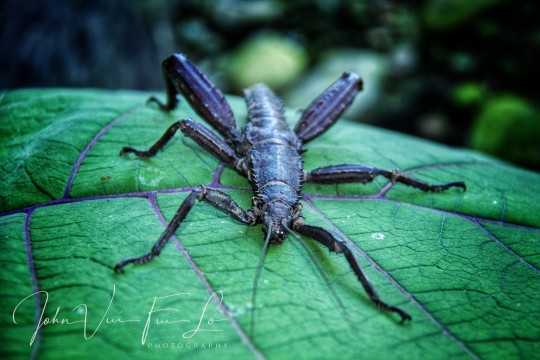

Lord Howe Island Stick Insect aka Tree Lobster (Dryococelus australis), family Phasmatidae, Lorde Howe Island, Australia
CRITICALLY ENDANGERED.
These large stick insects can grow up to 20 cm (8 in) in length.
They have been thought to be extinct at various times, but have been rediscovered in remote locations on the island periodically.
The introduction of Europeans - using them as bait, and black rats - who ate them, lead to their precipitous population decline.
photographs by John Vui Fui Lo
237 notes
·
View notes
Note
DID YOU SEE THAT THE LORD HOWE ISLAND COCKROACH HAS BEEN FOUND AGAIN! this is the second insect from lord howe island thought to be extinct that has been rediscovered (the first was the LHI stick insect, found again on nearby ball's pyramid)!!!!!
That is VERY exciting news!!! It was thought to be extinct since the 1930s.
Link about it here :)
304 notes
·
View notes
Text
Bug Brawl
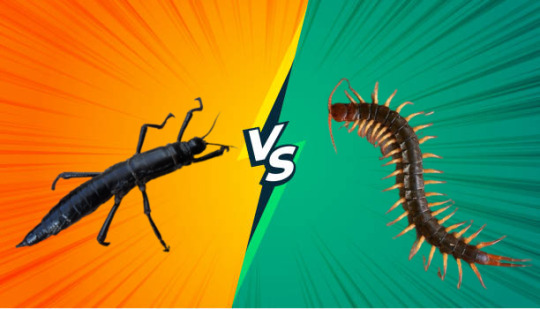
Why you should vote for them:
Tree Lobster
Big and rare. At one point, all known specimens came from one bush.
Centipede
cool looking legs ngl
40 notes
·
View notes
Text
Reblog for a bigger sample size.
Say in the tags what you voted for and if you live in or outside the US
#polls#lord howe island#I thought Lord Howe Island was a state and aparently it's not but I already made this soooo....#state poll#australia#islands#Land Lobster#Meiolania#Kentia palms#lol added an extra E to Lord(e) Howe Island#I'm not remaking this poll though
6 notes
·
View notes
Note
What are some vulnerable/threatened/endangered species that you think are cool? (This can include both animals and plants)
There's a few, so I'm only doing critically endangered Australian species.
The south coast underground orchid, Rhizanthella johnstonii, is native to Western Australia and one of the weirdest plansts I've ever seen. Their mature population is estimated at a max of 49, but the population is stable.

The Lord Howe Island stick insect, Dryococelus australis, was thought to be extinct since 1920 before it was rediscovered in 2001. It's considered the rarest insect in the world, and while once found throughout Lord Howe Island, it's now only found on the islet of Bell's Pyramid. They're being killed by invasive black rat population on the island, who eat the adults and young, and the estimated mature population on the island is a max 35 individuals. Efforts are being made to eradicate the rats from the island, and reintroduce mature breeding adults, since luckily this is a species that thrives in captivity. Their primary threat is invasive species.

The Wyong Midge orchid, Genoplesium insigne, is native to the Central Coast of New South Wales. Their population is decreasing, and their estimated mature max population is 19. Their primary threats are invasive species particularly predation by rabbits, habitat disturbances, and illegal collecting.

The green sawfish, Pristis zijsron, is found the northern oceanic and intertidal waters of Australia. They used to be very prevalent in the waters north of Kakadu. The IUCN doesn't list their estimated population, but it is known that it's decreasing. Their primary threat is overfishing, as their fins are used for shark fin soup, their snouts are considered souvenirs, and because their meat is often desired for use in traditional Asian medicine, specifically Chinese. Their snouts also make them get caught in fishing nets often, and they're often killed being being brought on boats because of the danger their snouts pose to humans. They're also threatened by habitat loss. This is a species culturally important to many Aborigine mobs, and a species that's often considered sacred.

The southern corroboree frog, Pseudophryne corroboree, is a frog native to the Southern Tablelands of NSW. For a frog they're unique--most frogs obtain their poisons from animals they eat, but corroboree frogs produce their own poison. Their primary threats are habitat destruction, feral animals, chrytrid ("frogkiller") funguses, and bushfires. Their max mature population is 50, and their population is decreasing.

The orange-bellied parrot, Neophema chrysogaster, is native to Tasmania, its only known breeding location. This is one of the three known migrating parrot species. Their maximum mature population is 25. Their primary threats are competition with invasive species, predation by invasive species, habitat loss, and disease.
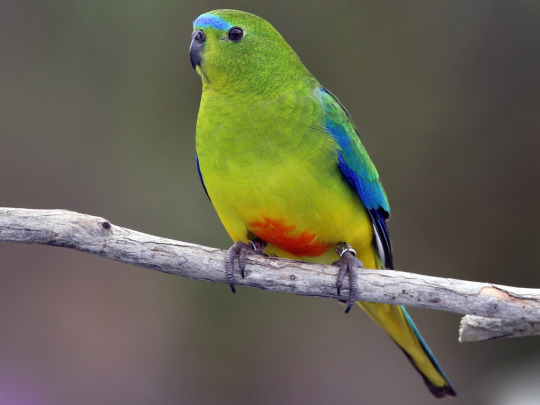
11 notes
·
View notes
Note
hi arden! what’s your favorite species of mammal, bird, reptile, amphibian, and insect?
Hiii thanks for asking! I will include visual aids
Mammal: CATS. Easy answer, perfect animal, no notes, this one specifically is the best one
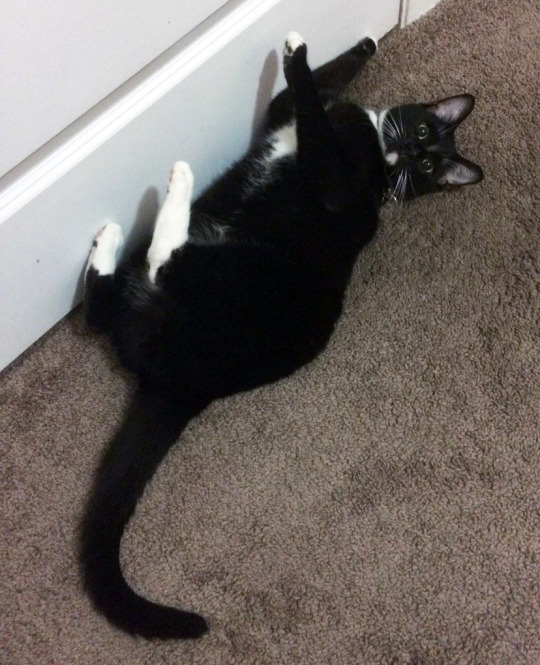
Bird: I wish I was more well-versed in birds but I'm very fond of kestrels
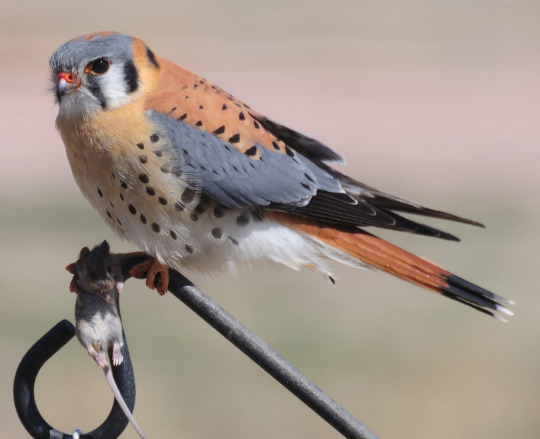
Reptile: Day geckos. Just look at this thing

Amphibian: Rough-skinned newt... no big reason I just think they're neat

Favorite insect is too hard so I will split this into three categories
Cute: Hummingbird hawk-moth

Cool: Lord Howe Island stick insect. Anyone who hasnt heard of them before please look them up they are neat as hell, supposedly went extinct in the 1900s but the species survived for 90 years through parthenogenesis on a tiny rock off the shore of their native island
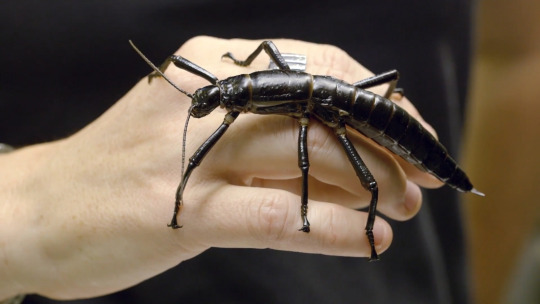
Personal attachment: Genus Scaphinotus, broadly. I've been reading a lot about these guys for my thesis and will hopefully include them as part of my research, they are neat little ground beetles that specialize in eating snails (hence the skinny little head for sticking inside the shell). There is not much in the way of research about them but from what I've seen they're notoriously finicky little creatures in the lab lol
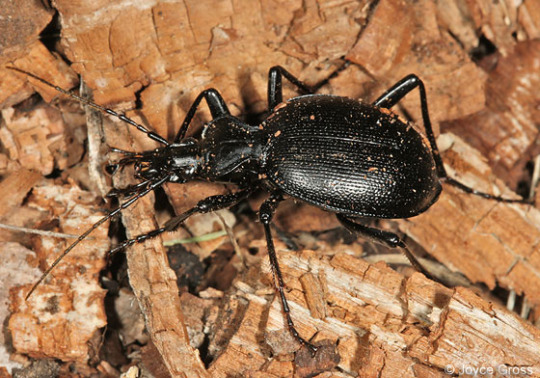
10 notes
·
View notes
Text
July 4th, 2022
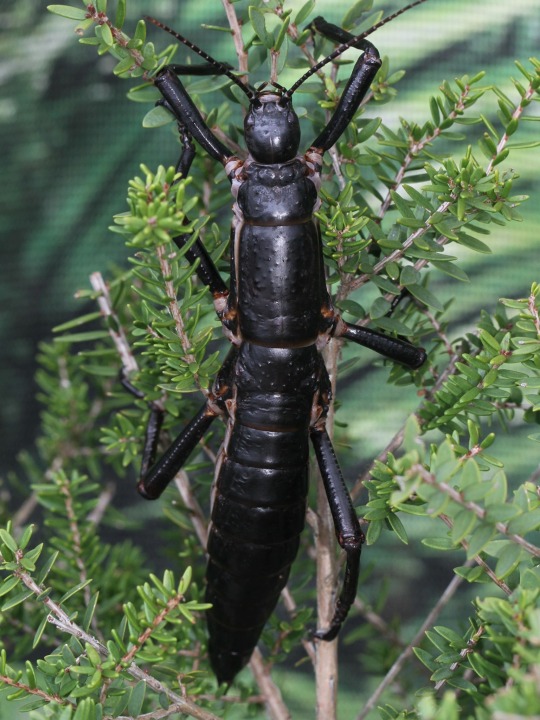
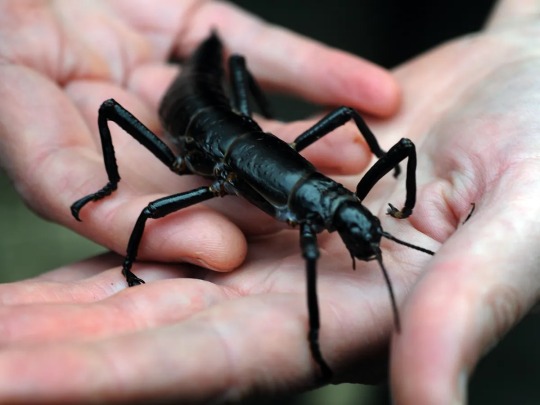
Lord Howe Island Stick Insect (Dryococelus australis)
Once referred to as the rarest insect in the world, the Lord Howe Island stick insect, also known colloquially as the tree lobster, is native to Lord Howe Island and a nearby volcanic outcrop called Ball's Pyramid. That's only around 15 km² of land! They are now only found on Ball's Pyramid, having been extirpated from their native island after the introduction of invasive black rats by an Australian supply ship in 1918 (alongside twelve other invertebrate species and five bird species).
Unlike many other insect species, tree lobsters form bonded pairs, even sleeping together side-by-side. Females can also reproduce asexually by parthenogenesis. It is estimated that there are only 25–30 mature adults remaining in the wild but, thankfully, these odd insects reproduce very well in captivity and captive numbers are well into the thousands at the Melbourne, San Diego, Bristol and Toronto zoos!
Tree lobsters feed almost exclusively on melaleuca bushes, but it is suggested that they may have a more diverse diet than what was originally thought. They are nocturnal, and spend the days hiding in accumulated plant debris, beneath maleleuca bushes and in rock crevices. During the night, they are most active—they are slow-moving and do not possess wings like other phasmids, and thus tend to remain fairly stationary. They do occupy their time, however; bonded pairs have been observed mating three times per night!
Evolutionarily speaking, the Lord Howe Island stick insect has a completely separate lineage from other Australasian phasmids—in fact, they're so old that they predate the formation of Lord Howe Island. Who knows how they got there?
17 notes
·
View notes
Text
Australians clueless about their country's most endangered species
https://sciencespies.com/nature/australians-clueless-about-their-countrys-most-endangered-species/
Australians clueless about their country's most endangered species

Australia holds an unenviable conservation status: it’s the fourth-worst country in the world for species extinctions and is in the top three for critically endangered animals.
This week’s Federal Budget included a $224 million allocation to help save threatened species – news that coincides with some concerning findings of a new paper authored by University of South Australia (UniSA) researchers.
A study led by UniSA conservation psychologist Dr Elissa Pearson reveals overwhelming public ignorance of Australia’s most threatened species, a factor that is contributing to the extinction crisis of endangered animals.
UniSA researchers, alongside colleagues from Zoos Victoria and Edith Cowan University, polled more than 300 zoo visitors and community members, testing their awareness of seven endangered species at risk of extinction within the next decade.
“More than 90 per cent of those surveyed did not recognise six of the seven species; the exception being the Tasmanian devil,” Dr Pearson says.
The other species were the Leadbeater’s possum, eastern barred bandicoot, helmeted honeyeater, southern corroboree frog, Lord Howe Island (LHI) stick insect, and orange-bellied parrot.
advertisement
The Journal for Nature Conservation paper outlines a clear link between species recognition, likeability and conservation support, showing that people are far more inclined to donate toward conserving Australia’s iconic koala, kangaroo and wombat populations, despite these not being endangered.
“There are huge gaps in community knowledge regarding native Australian wildlife, with less than eight per cent of people able to correctly name six of seven endangered species when shown photographs.
“Apart from the Tasmanian devil, which 86 per cent of people recognised, the level of familiarity and knowledge of our vulnerable species is limited. Misidentification is also common, particularly the eastern barred bandicoot which is often mistaken for a bilby.”
The most likeable Australian animals – the koala and kangaroo – also reflect the ‘similarity principle’, which suggests that people tend to prefer animals most like humans, and that when only a limited number of species can be conserved, mammals are favoured over other species, regardless of their endangered status.
The helmeted honeyeater, southern corroboree frog and LHI stick insect were consistently the least liked species.
“Apart from the likeability factor, our study showed that being able to recognise species increased people’s willingness to support their conservation, so that is a starting point we need to address.”
Endangered insects are fighting an uphill battle for support, with 85 per cent of people disliking them, putting their survival at most risk. However, this perception could be changed with some clever marketing initiatives, the researchers suggest.
“The LHI stick insect has some exceptional qualities, such as their resilience and survival against all odds, their ability to reproduce without males, their tendency to form large social groups during the day, or even the fact that their foot pads are heart shaped. If people knew these facts the likeability factor would likely shoot up,” Dr Pearson says.
#Nature
#10-2022 Science News#2022 Science News#acts of science#Earth Environment#earth science#Environment and Nature#everyday items#Nature Science#New#News Science Spies#October 2022 Science News#Our Nature#planetary science#production line#sci_evergreen1#Science#Science Channel#science documentary#Science News#Science Spies#Science Spies News#Space Physics & Nature#Space Science#Nature
3 notes
·
View notes
Text
18 Nobles AU (Part 1)
(Why do I do this to myself)
This was partially born out of my other AUs, partially out of some of my disappointments with Gen 8.
Basically, this is an AU where instead of 10 nobles, divided between two clans and five areas, there are 18 nobles divided across three clans and six areas. This is probably going to need multiple posts, so I'll stick with new Pokémon and new Nobles for now. Even so, it's gonna be long so I'll stick it undrr the Read More.
New Pokémon!
Every Pokémon from Gen V onwards that were not in SwSh are present in the 18 Nobles AU (Don't ask how.)
Every Pokémon in the Platinum Sinnoh Dex that were excluded from Hisui in canon are retained here.
Since the Gen V starters are covered by the "Gen V onwards but not in SwSh" but the Gen II and VII starters aren't, those starters are added in anyway to prevent Gen V getting more attention than the other generations the Hisui starters originate from. However, Gen II, V, VI, and VII starters cannot be found until the post game.
Lastly, a few other Pokémon are included due to connection with the new Nobles.
New Nobles:
Lady Akaryu (Platinum Clan, Obsidian Fieldlands). Originating from my Akaryu AU, this is the only noble to be entirely original to Hisui, neither evolving from nor being a regional variant of an existing Pokémon. She takes a role similar to Lilligant or Avalugg, being the protector of the Platinum Clan settlement. She is Dragon-Fairy type, and carries the Pixie Plate.
Lady Swanna (Platinum Clan, Crimson Mirelands) Look, I know that Swan Boats are not in any way related to Hokkaido, but I was struggling okay? Lady Swanna is the first Platinum Clan noble you face. She is Steel-Water type, and gives you the Iron Plate.
Lady Paracide (Platinum Clan, Jade Flatlands) Originating from my Paras Whisperer AU, Lady Paracide serves as the Ride Pokémon for the new Jade Flatlands (which I will cover in a later post). She can stretch upwards to help you ford treacherous material or spring upwards to give you a burst of elevation. She is Bug-Ghost type and gives you the Spooky Plate.
Lord (Zangoose Evo) (Diamond Clan, Jade Flatlands) Look, I'm not great with Pokémon names, okay? This lord, along with Hisuian Zangoose, is Normal-Ice type and gives you the Blank Plate. Of course, he is closely tied to...
Lady (Seviper Evo) (Pearl Clan, Jade Flatlands) What else? Seviper have been chased off from the Hisuian mainland until recently. Despite making a comeback, they seem to be much less at odds with Hisuian Zangoose. This Lady is found near what will one day become Iron Island. She is Dragon-Water type, while Hisuian Seviper are pure Dragon type, and she gives you the Draco Plate.
Lady (Medicham Evolution) (Platinum Clan, Cobalt Coastlands) This evolution line is entirely based on the Dragon Warrior trope in many martial arts films, taking such a concept much more literally. This Lady resides inland, in a small cove in the northwest corner of the map. (By the way the maps are bigger.) She, along with Hisuian Meditite and Medicham, are Fighting-Dragon type, and she gives you the Fist Plate.
Lady Galvantula (Platinum Clan, Coronet Highlands) Loosely originating from my post about Emmet introducing Joltik to Hisui and them becoming an invasive species, Lady Galvantula is a regional variant of Galvantula that has adapted to an environment with low amounts of natural electricity. She is Bug-Fairy type and gives you the Insect Plate (Kleavor gives you the Stone Plate instead).
Lady (Noctowl Evolution) (Platinum Clan, Alabaster Icelands) This is the only new noble who outright replaces an existing Ride Noble, namely Braviary. She is Dark-Flying type and gives you the Dread Plate.
#my aus#aus#18 nobles au#akaryu au#paras whisperer au#if anyone has ideas for names for the unnamed nobles please feel free to share#first thoughts
1 note
·
View note
Text
“Here's the story: About 13 miles from this spindle of rock, there's a bigger island, called Lord Howe Island.
On Lord Howe, there used to be an insect, famous for being big. It's a stick insect, a critter that masquerades as a piece of wood, and the Lord Howe Island version was so large — as big as a human hand — that the Europeans labeled it a "tree lobster" because of its size and hard, lobsterlike exoskeleton. It was 12 centimeters long and the heaviest flightless stick insect in the world. Local fishermen used to put them on fishing hooks and use them as bait.
Then one day in 1918, a supply ship, the S.S. Makambo from Britain, ran aground at Lord Howe Island and had to be evacuated. One passenger drowned. The rest were put ashore. It took nine days to repair the Makambo, and during that time, some black rats managed to get from the ship to the island, where they instantly discovered a delicious new rat food: giant stick insects. Two years later, the rats were everywhere and the tree lobsters were gone.
Totally gone. After 1920, there wasn't a single sighting. By 1960, the Lord Howe stick insect, Dryococelus australis, was presumed extinct.
—
Nick Carlile and a local ranger, Dean Hiscox, agreed to make the climb. And with flashlights, they scaled the wall till they reached the plant, and there, spread out on the bushy surface, were two enormous, shiny, black-looking bodies. And below those two, slithering into the muck, were more, and more ... 24 in all. All gathered near this one plant.
They were alive and, to Nick Carlile's eye, enormous. Looking at them, he said, "It felt like stepping back into the Jurassic age, when insects ruled the world."
They were Dryococelus australis. A search the next morning, and two years later, concluded these are the only ones on Ball's Pyramid, the last ones. They live there, and, as best we know, nowhere else.”
#ecology#environment#conservation#insects#bugs#nature#it makes me so emotional when animals presumed extinct survive under the radar
0 notes
Text
Un phasme géant endémique d'une île australienne - considéré comme l'insecte le plus rare du monde - pourrait bien être en train d'inverser la tendance, assurant sa survie
See on Scoop.it - EntomoNews
... cette espèce australienne de phasmes sauvages de l'île Lord Howe (Dryococelus australis) [est] passée tout près de l'extinction. Mais cet insecte le plus rare du monde fait de la résistance.
Chloé Gurdjian Publié le 15/01/2024 à 13h01
"Comme le révèle Science Alert, on a un temps cru ces phasmes disparus, avant qu'ils ne soient finalement redécouverts 80 ans plus tard, en 2001. Aujourd'hui, la population sauvage ne compte que 20 à 30 individus, sur un affleurement volcanique presque vertical appelé Ball's Pyramid, sur l'île Lord Howe, au large de Sydney.
Et comme l'indique le média australien, les lieux ne sont pas exactement idéaux pour accueillir une espèce en voie d'extinction, l'île étant sujette à des phénomènes météorologiques catastrophiques et à des glissements de terrain. De plus, les homards arboricoles ne mangent qu'une plante, Melaleuca howeana. Or celle-ci est "étranglée par une vigne envahissante, qui ne peut être entièrement éliminée car ses racines retiennent la terre sur les falaises".
Pourquoi le homard arboricole est-il menacé ?
Tout n'a pas toujours été si compliqué pour ce phasme australien, qui se comptait autrefois en nombre. Mais l'arrivée des rats sur l'île en 1918 a tout changé. Les rongeurs les ont dévorés, "jusqu'à ce qu'aucun homard arboricole ne soit trouvé", exterminant au passage d'autres espèces indigènes, dont cinq espèces d'oiseaux, deux espèces de plantes et 12 espèces d'invertébrés.
Plus aperçu depuis 1920, le phasme a finalement été déclaré éteint en 1986... avant sa redécouverte plusieurs années plus tard. En 2003, des scientifiques ont réussi à capturer sans les blesser quatre individus, pour lancer un programme de reproduction.
"Cet incroyable exploit de survie, malgré un nombre extrêmement faible dans un endroit aussi désolé, est probablement dû à la capacité de la femelle à se cloner par reproduction parthénogénétique", expliquent les scientifiques.
-------
NDÉ
Article source
→ World's 'Rarest Insect' Makes Stunning Comeback After Near-Extinction : ScienceAlert, 14 January 2024. By Tessa Koumoundouros https://www.sciencealert.com/worlds-rarest-insect-makes-stunning-comeback-after-near-extinction
[Image] Lord Howe Island Stick Insect (Dryococelus australis) (Zoos Victoria)
Bernadette Cassel's insight:
https://www.scoop.it/topic/entomonews?q=Dryococelus+australis
0 notes